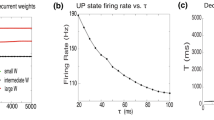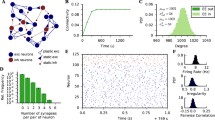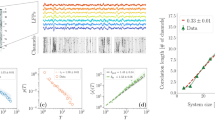Abstract
Criticality signatures, in the form of power-law distributed neuronal avalanches, have been widely measured in vitro and provide the foundation for the so-called critical brain hypothesis, which proposes that healthy neural circuits operate near a phase transition state with maximal information processing capabilities. Here, we revisit a recently published analysis on the occurrence of those signatures in the activity of a recurrent neural network model that self-organizes due to biologically inspired plasticity rules. Interestingly, the criticality signatures are input dependent: they transiently break down due to onset of random external input, but do not appear under repeating input sequences during learning tasks. Additionally, we show that an important information processing ability, the fading memory time scale, is improved when criticality signatures appear, potentially facilitating complex computations. Taken together, the results suggest that a combination of plasticity mechanisms that improves the network’s spatio-temporal learning abilities and memory time scale also yields power-law distributed neuronal avalanches under particular input conditions, thus suggesting a link between such abilities and avalanche criticality.
Access this chapter
Tax calculation will be finalised at checkout
Purchases are for personal use only
Similar content being viewed by others
References
Alstott, J., Bullmore, E., Plenz, D.: powerlaw: a python package for analysis of heavy-tailed distributions. PloS One 9(1), e85,777 (2014)
de Arcangelis, L., Perrone-Capano, C., Herrmann, H.J.: Self-organized criticality model for brain plasticity. Phys. Rev. Lett. 96(2), 028,107 (2006)
Arviv, O., Goldstein, A., Shriki, O.: Near-critical dynamics in stimulus-evoked activity of the human brain and its relation to spontaneous resting-state activity. J. Neurosci. 35(41), 13927–13942 (2015)
Bak, P., Tang, C., Wiesenfeld, K.: Self-organized criticality: An explanation of the 1/f noise. Phys. Rev. Lett. 59(4), 381 (1987)
Bedard, C., Kroeger, H., Destexhe, A.: Does the 1/f frequency scaling of brain signals reflect self-organized critical states? Phys. Rev. Lett. 97(11), 118,102 (2006)
Beggs, J.M., Plenz, D.: Neuronal avalanches in neocortical circuits. J. Neurosci. 23(35), 11167–11177 (2003)
Beggs, J.M., Timme, N.: Being critical of criticality in the brain. Front. Physiol. 3 (2012)
Bertschinger, N., Natschläger, T.: Real-time computation at the edge of chaos in recurrent neural networks. Neural Comput. 16(7), 1413–1436 (2004)
Bertschinger, N., Rauh, J., Olbrich, E., Jost, J.: Shared information–new insights and problems in decomposing information in complex systems. In: Proceedings of the European Conference on Complex Systems 2012, pp. 251–269. Springer (2013)
Bi, G.Q., Poo, M.M.: Synaptic modifications in cultured hippocampal neurons: dependence on spike timing, synaptic strength, and postsynaptic cell type. J. Neurosci. 18(24), 10,464–10,472 (1998)
Boedecker, J., Obst, O., Lizier, J.T., Mayer, N.M., Asada, M.: Information processing in echo state networks at the edge of chaos. Theory Biosci. 131(3), 205–213 (2012)
Chialvo, D.R.: Emergent complex neural dynamics. Nat. Phys. 6(10), 744–750 (2010)
Clauset, A., Shalizi, C.R., Newman, M.E.: Power-law distributions in empirical data. SIAM Rev. 51(4), 661–703 (2009)
Dahmen, D., Diesmann, M., Helias, M.: Distributions of covariances as a window into the operational regime of neuronal networks (2016). arXiv:1605.04153
Dahmen, D., Grün, S., Diesmann, M., Helias, M.: Two types of criticality in the brain (2017). arXiv:1711.10930
Del Papa, B., Priesemann, V., Triesch, J.: Criticality meets learning: criticality signatures in a self-organizing recurrent neural network. PloS One 12(5), e0178,683 (2017)
Duarte, R., Series, P., Morrison, A.: Self-organized artificial grammar learning in spiking neural networks. In: Proceedings of the 36th Annual Conference of the Cognitive Science Society, pp. 427–432 (2014)
Friedman, N., Ito, S., Brinkman, B.A., Shimono, M., DeVille, R.L., Dahmen, K.A., Beggs, J.M., Butler, T.C.: Universal critical dynamics in high resolution neuronal avalanche data. Phys. Rev. Lett. 108(20), 208,102 (2012)
Gautam, S.H., Hoang, T.T., McClanahan, K., Grady, S.K., Shew, W.L.: Maximizing sensory dynamic range by tuning the cortical state to criticality. PLoS Comput. Biol. 11(12), e1004,576 (2015)
Haldeman, C., Beggs, J.M.: Critical branching captures activity in living neural networks and maximizes the number of metastable states. Phys. Rev. Lett. 94(5), 058,101 (2005)
Hartmann, C., Lazar, A., Nessler, B., Triesch, J.: Where’s the noise? Key features of spontaneous activity and neural variability arise through learning in a deterministic network. PLoS Comput. Biol. 11(12), e1004,640–e1004,640 (2015)
Hesse, J., Gross, T.: Self-organized criticality as a fundamental property of neural systems. Front. Syst. Neurosci. 8, (2014)
Jaeger, H.: Tutorial on training recurrent neural networks, covering BPPT, RTRL, EKF and the “echo state network” approach, vol. 5. GMD-Forschungszentrum Informationstechnik (2002)
Kanders, K., Lorimer, T., Stoop, R.: Avalanche and edge-of-chaos criticality do not necessarily co-occur in neural networks. Chaos Interdiscip. J. Nonlinear Sci. 27(4), 047,408 (2017)
Kanders, K., Lorimer, T., Uwate, Y., Steeb, W.H., Stoop, R.: Robust transformations of firing patterns for neural networks (2017). arXiv:1708.04168
Kinouchi, O., Copelli, M.: Optimal dynamical range of excitable networks at criticality. Nat. Phys. 2(5), 348–351 (2006)
Lazar, A., Pipa, G., Triesch, J.: Fading memory and time series prediction in recurrent networks with different forms of plasticity. Neural Netw. 20(3), 312–322 (2007)
Lazar, A., Pipa, G., Triesch, J.: Sorn: a self-organizing recurrent neural network. Front. Comput. Neurosci. 3 (2009)
Lazar, A., Pipa, G., Triesch, J.: Emerging bayesian priors in a self-organizing recurrent network. In: Artificial Neural Networks and Machine Learning–ICANN 2011, pp. 127–134. Springer (2011)
Legenstein, R., Maass, W.: Edge of chaos and prediction of computational performance for neural circuit models. Neural Netw. 20(3), 323–334 (2007)
Levina, A., Herrmann, J.M., Geisel, T.: Dynamical synapses causing self-organized criticality in neural networks. Nature Phys. 3(12), 857–860 (2007)
Levina, A., Priesemann, V.: Subsampling scaling. Nat. Commun. 8, 15,140 (2017)
Lombardi, F., Herrmann, H., Perrone-Capano, C., Plenz, D., De Arcangelis, L.: Balance between excitation and inhibition controls the temporal organization of neuronal avalanches. Phys. Rev. Lett. 108(22), 228,703 (2012)
Lukoševičius, M.: A practical guide to applying echo state networks. In: Neural Networks: Tricks of the Trade, pp. 659–686. Springer (2012)
Maass, W., Natschläger, T., Markram, H.: Real-time computing without stable states: a new framework for neural computation based on perturbations. Neural Comput. 14(11), 2531–2560 (2002)
Massobrio, P., de Arcangelis, L., Pasquale, V., Jensen, H.J., Plenz, D.: Criticality as a signature of healthy neural systems. Front. Syst. Neurosci. 9 (2015)
Meisel, C., Gross, T.: Adaptive self-organization in a realistic neural network model. Phys. Rev. E 80(6), 061,917 (2009)
Palva, J.M., Zhigalov, A., Hirvonen, J., Korhonen, O., Linkenkaer-Hansen, K., Palva, S.: Neuronal long-range temporal correlations and avalanche dynamics are correlated with behavioral scaling laws. Proc. Natl. Acad. Sci. 110(9), 3585–3590 (2013)
Palva, S., Palva, J.M.: Roles of brain criticality and multiscale oscillations in temporal predictions for sensorimotor processing. Trends Neurosci. 41(10), 729–743 (2018)
Petermann, T., Thiagarajan, T.C., Lebedev, M.A., Nicolelis, M.A., Chialvo, D.R., Plenz, D.: Spontaneous cortical activity in awake monkeys composed of neuronal avalanches. Proc. Natl. Acad. Sci. 106(37), 15921–15926 (2009)
Plenz, D.: Viewpoint: the critical brain. Physics 6, 47 (2013)
Poil, S.S., Hardstone, R., Mansvelder, H.D., Linkenkaer-Hansen, K.: Critical-state dynamics of avalanches and oscillations jointly emerge from balanced excitation/inhibition in neuronal networks. J. Neurosci. 32(29), 9817–9823 (2012)
Priesemann, V., Munk, M.H., Wibral, M.: Subsampling effects in neuronal avalanche distributions recorded in vivo. BMC Neurosci. 10(1), 40 (2009)
Priesemann, V., Shriki, O.: Can a time varying external drive give rise to apparent criticality in neural systems? PLoS Comput. Biol. 14(5), e1006,081 (2018)
Priesemann, V., Valderrama, M., Wibral, M., Le Van Quyen, M.: Neuronal avalanches differ from wakefulness to deep sleep–evidence from intracranial depth recordings in humans. PLoS Comput. Biol. 9(3), e1002,985 (2013)
Priesemann, V., Wibral, M., Valderrama, M., Pröpper, R., Le Van Quyen, M., Geisel, T., Triesch, J., Nikolić, D., Munk, M.H.: Spike avalanches in vivo suggest a driven, slightly subcritical brain state. Front. Syst. Neurosci. 8 (2014)
Ribeiro, T.L., Copelli, M., Caixeta, F., Belchior, H., Chialvo, D.R., Nicolelis, M.A., Ribeiro, S.: Spike avalanches exhibit universal dynamics across the sleep-wake cycle. PloS One 5(11), e14,129 (2010)
Schwab, D.J., Nemenman, I., Mehta, P.: Zipf’s law and criticality in multivariate data without fine-tuning. Phys. Rev. Lett. 113(6), 068,102 (2014)
Scott, G., Fagerholm, E.D., Mutoh, H., Leech, R., Sharp, D.J., Shew, W.L., Knöpfel, T.: Voltage imaging of waking mouse cortex reveals emergence of critical neuronal dynamics. J. Neurosci. 34(50), 16611–16620 (2014)
Shew, W.L., Clawson, W.P., Pobst, J., Karimipanah, Y., Wright, N.C., Wessel, R.: Adaptation to sensory input tunes visual cortex to criticality. Nat. Phys. 11(8), 659–663 (2015)
Shew, W.L., Plenz, D.: The functional benefits of criticality in the cortex. Neuroscientist 19(1), 88–100 (2013)
Shew, W.L., Yang, H., Petermann, T., Roy, R., Plenz, D.: Neuronal avalanches imply maximum dynamic range in cortical networks at criticality. J. Neurosci. 29(49), 15595–15600 (2009)
Shew, W.L., Yang, H., Yu, S., Roy, R., Plenz, D.: Information capacity and transmission are maximized in balanced cortical networks with neuronal avalanches. J. Neurosci. 31(1), 55–63 (2011)
Shriki, O., Alstott, J., Carver, F., Holroyd, T., Henson, R.N., Smith, M.L., Coppola, R., Bullmore, E., Plenz, D.: Neuronal avalanches in the resting meg of the human brain. J. Neurosci. 33(16), 7079–7090 (2013)
Stepp, N., Plenz, D., Srinivasa, N.: Synaptic plasticity enables adaptive self-tuning critical networks. PLoS Comput. Biol. 11(1) (2015)
Tagliazucchi, E., Balenzuela, P., Fraiman, D., Chialvo, D.R.: Criticality in large-scale brain fmri dynamics unveiled by a novel point process analysis. Front. Physiol. 3(15) (2012). https://doi.org/10.3389/fphys.2012.00015
Tetzlaff, C., Okujeni, S., Egert, U., Wörgötter, F., Butz, M.: Self-organized criticality in developing neuronal networks. PLoS Comput. Biol. 6(12), e1001,013 (2010)
Tomen, N., Rotermund, D., Ernst, U.: Marginally subcritical dynamics explain enhanced stimulus discriminability under attention. Front. Syst. Neurosci. 8, 151 (2014)
Touboul, J., Destexhe, A.: Can power-law scaling and neuronal avalanches arise from stochastic dynamics. PloS One 5(2), e8982 (2010)
Uhlig, M., Levina, A., Geisel, T., Herrmann, J.M.: Critical dynamics in associative memory networks. Front. Comput. Neurosci. 7 (2013)
Wibral, M., Finn, C., Wollstadt, P., Lizier, J.T., Priesemann, V.: Quantifying information modification in developing neural networks via partial information decomposition. Entropy 19(9), 494 (2017)
Wibral, M., Lizier, J.T., Priesemann, V.: Bits from brains for biologically inspired computing. Front. Robot. AI 2, 5 (2015)
Williams, P.L., Beer, R.D.: Nonnegative decomposition of multivariate information (2010). arXiv:1004.2515
Williams-García, R.V., Moore, M., Beggs, J.M., Ortiz, G.: Quasicritical brain dynamics on a nonequilibrium widom line. Phys. Rev. E 90(6), 062,714 (2014)
Wilting, J., Dehning, J., Neto, J.P., Rudelt, L., Wibral, M., Zierenberg, J., Priesemann, V.: Dynamic adaptive computation: tuning network states to task requirements (2018). arXiv:1809.07550
Wilting, J., Priesemann, V.: Inference, validation and predictions about statistics and propagation of cortical spiking in vivo, p. 363085 (2018)
Wilting, J., Priesemann, V.: Inferring collective dynamical states from widely unobserved systems. Nat. Commun. 9(1), 2325 (2018)
Yaghoubi, M., de Graaf, T., Orlandi, J.G., Girotto, F., Colicos, M.A., Davidsen, J.: Neuronal avalanche dynamics indicates different universality classes in neuronal cultures. Sci. Rep. 8(1), 3417 (2018)
Zheng, P., Dimitrakakis, C., Triesch, J.: Network self-organization explains the statistics and dynamics of synaptic connection strengths in cortex. PLoS Comput. Biol. 9(1), e1002,848 (2013)
Zheng, P., Triesch, J.: Robust development of synfire chains from multiple plasticity mechanisms. Front. Comput. Neurosci. 8, 66 (2014)
Zierenberg, J., Wilting, J., Priesemann, V.: Homeostatic plasticity and external input shape neural network dynamics. Phys. Rev. X 8(3), 031,018 (2018)
Author information
Authors and Affiliations
Corresponding author
Editor information
Editors and Affiliations
Appendix
Appendix
1.1 Power-Law Fitting
Although power-laws are very common in nature, their characterization is particularly complex and must be carefully evaluated. In particular, many false positives may appear, ranging from inaccurate exponents to wrong distribution fits [13]. Such problems can be better understood and avoided using maximum likelihood estimators. In this study, we followed the procedure of a previous work [16], employing the powerlaw python package [1] in order to estimate the distributions exponents. For all the probability distributions of avalanche durations and sizes shown here, power-laws with cut-offs provided better fits when compared to other single parameter distributions, such as exponential distributions. The cut-off was chosen in a case by case analysis, based on the best power-law fit. For a step-by-step description of power-law fitting via maximum likelihood estimators, see [13].
Rights and permissions
Copyright information
© 2019 Springer Nature Switzerland AG
About this chapter
Cite this chapter
Del Papa, B., Priesemann, V., Triesch, J. (2019). Fading Memory, Plasticity, and Criticality in Recurrent Networks. In: Tomen, N., Herrmann, J., Ernst, U. (eds) The Functional Role of Critical Dynamics in Neural Systems . Springer Series on Bio- and Neurosystems, vol 11. Springer, Cham. https://doi.org/10.1007/978-3-030-20965-0_6
Download citation
DOI: https://doi.org/10.1007/978-3-030-20965-0_6
Published:
Publisher Name: Springer, Cham
Print ISBN: 978-3-030-20964-3
Online ISBN: 978-3-030-20965-0
eBook Packages: Biomedical and Life SciencesBiomedical and Life Sciences (R0)




